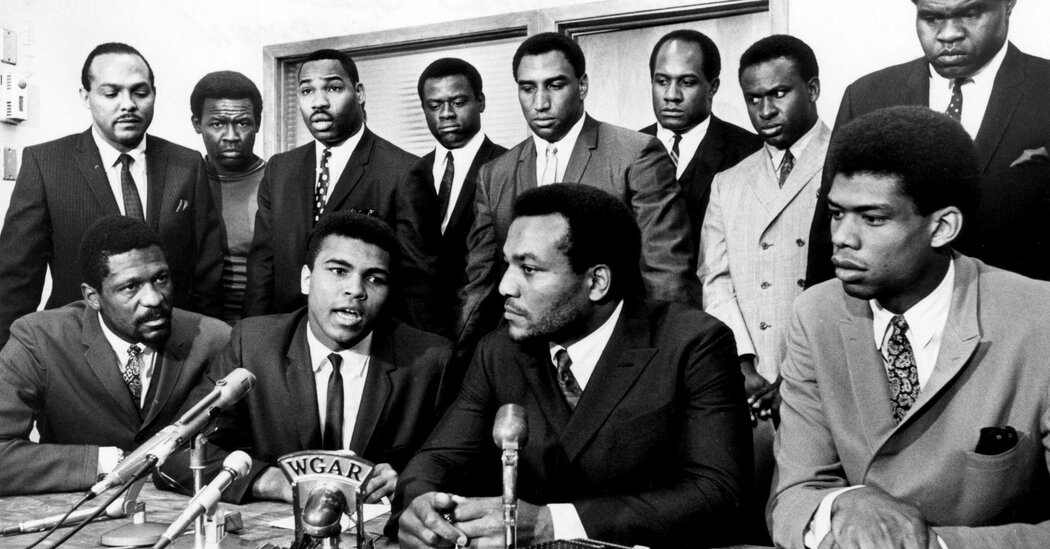Secretariat’s Legend Rolls on Like, Well, a Tremendous Machine
It was a performance for the ages, growing more mythic as time goes on. Having won the Kentucky Derby and the Preakness Stakes in record fashion, Secretariat rocketed out of the starting gate on June 9, 1973 — his best start yet — and never let up. He moved “liked a tremendous machine,” as the announcer Chic Anderson put it, and crushed his competition by a whopping 31 lengths to win the Belmont Stakes on an uncomfortably warm but utterly joyous afternoon at Belmont Park.
Like his lead in the Belmont, his legend has swelled even though his youngest current fans had not even been born when he was crowned the ninth Triple Crown champion and the first in 25 years. Nine of the best 3-year-olds in the country will face off Saturday during the 50th anniversary celebration of Secretariat’s Triple Crown feat, but none will even come close to achieving the superstar status of the big red horse.
“I was amazed with that horse all along,” said his jockey, Ron Turcotte, who at 81 is the lone survivor of Secretariat’s inner circle, which included the owner Penny Chenery, the trainer Lucien Laurin and the groom Eddie Sweat. “He was doing things that we’ve never seen before that we’ll probably never see again.”
In the Derby, Secretariat broke a step slow, but Turcotte, unworried, let the colt find his legs and run his race. At the top of the stretch, Turcotte asked for more, and Secretariat zipped past his rival Sham to win by two and a half lengths in 1 minute 59⅖ seconds. He ran each quarter-mile faster than the one before, unheard-of in horse racing.
In the Preakness, Turcotte made a bold decision to launch a spectacular move on the first turn. After taking the lead, Secretariat was never challenged, and he won by two and a half lengths. Sham again settled for second. Secretariat’s final time was recorded as 1:55, a second slower than the Preakness record. But clockers recorded faster times, and by Monday, the stewards voted to change the official time to their clocker’s mark of 1:54⅖, still short of the record. It wasn’t until 2012, after Chenery hired companies to conduct a forensic review of the race using technology that hadn’t existed in 1973, that the Maryland Racing Commission agreed to change the official time to 1:53, establishing the record at last.
Then came the Belmont, his pièce de résistance. If Anderson’s call of the race was the pinnacle of his lyrical craft, then a picture credited to the track photographer Bob Coglianese was its visual counterpart. It shows Secretariat head on, hooves hovering above the track in full flight, as Turcotte looks over his left shoulder at the timer that would register Secretariat as running the Belmont in 2:24, two seconds faster than any horse before or after. A blue-and-white checked pole — the color of Chenery’s silks — marks the margin of victory, almost unbelievable in scope. “I still had a lot of horse when I passed the wire,” Turcotte said. “He wasn’t even sweating.”
Adam Coglianese, who took over as official track photographer when his father retired, said of the photograph: “That stride is exactly what we would look for today. It’s basically dumb luck. When you shoot one frame, like they did back then, you can’t plan what you’re going to get.”
A recent account questioned whether Bob Coglianese, who was the New York Racing Association’s track photographer for over 50 years, had taken the picture at all. Adam Coglianese disputed any claim to the contrary but acknowledged that he knew little of the particulars of the black-and-white shot, including whether it had even been developed that night.
“He was very cautious about everything we did,” Adam Coglianese said of his father. “I don’t think people understand what goes into preparing for a Triple Crown. For weeks going into American Pharoah’s race, I was drawing a map of where each of my 20 photographers would stand.”
Whether Bob Coglianese, who died last year at 88, or someone else on his team shot the image only seems to add to the horse’s legend, which extended far beyond the racetrack.
Star Status, in Retirement and Death
In Paris, Ky., off Secretariat Way, sits Claiborne Farm, one of America’s most storied breeding operations. Its black-and-yellow breeding shed, built in 1910, has produced 22 winners of the Derby, 20 of the Preakness, 22 of the Belmont and six of the 13 Triple Crown champions, including Secretariat.
A corner stall in the stallion barn still bears Secretariat’s name and that of his sire, Bold Ruler, among those of other elites who have inhabited the space. Father and son are buried behind the office in a graveyard that is a who’s who of thoroughbred royalty.
On most days, Secretariat’s modest gravestone is draped with mementos from fans, who mark every birthday and anniversary with roses — some red, some painted blue. They also leave pennies, a nod to Chenery, an unlikely heroine who took over her father’s farm early in Secretariat’s career and saved it with the horse’s Triple Crown run and the $6.08 million syndication of his breeding rights, a record at the time.
“He kind of was like a rallying cry for America,” the Claiborne president, Walker Hancock, said, invoking the era of Richard Nixon, the Watergate scandal and the end of the Vietnam War. “He kind of brought everyone together after everyone was so divided.”
Secretariat’s popularity — he graced the covers of Time, Newsweek and Sports Illustrated and was the subject of a Disney movie — reinvigorated the farm from the day he arrived on Nov. 12, 1973, when several hundred people greeted him at Blue Grass Airport in Lexington. Thousands more flocked to Claiborne each year. So many showed up that a privacy fence had to be erected alongside the road.
“They thought they could just walk over and pet a stallion,” Joe Peel, the stallion manager, said with a chuckle.
The tours have continued since Secretariat’s death on Oct. 4, 1989, at age 19 from laminitis, a painful hoof disease. Dr. Thomas Swerczek of the University of Kentucky performed Secretariat’s necropsy and estimated his heart to be about 21 to 22 pounds, or nearly two and a half times larger than the average thoroughbred’s.
As with the photograph, there is no proof, as the necropsy was performed hastily and without proper equipment and documentation, according to an interview in 2020. But Swerczek stood by his assertion until he died last year at 82.
Outlasting the Field, and Time
The National Museum of Racing and Hall of Fame in Saratoga Springs, N.Y., has not had a traveling exhibit in over two decades. It took Secretariat’s milestone to get the museum back on the road.
The exhibit, titled “A Tremendous Machine” after Anderson’s call of the race, has followed Secretariat’s Triple Crown path, traveling to Louisville, Baltimore and now Elmont, N.Y. Its final stop will be at Colonial Downs in September because Secretariat was born in Virginia, at Chenery’s Meadow Farm.
Along the way, organizers have been collecting stories and photographs from visitors. Some saw Secretariat race; others visited him at the farm. Some owned his descendants. Several have locks of his hair. One man, who was stationed overseas while in the Army in 1973, recalled listening to the Belmont on the radio and crying tears of joy.
“It just makes people feel so good,” said Cate Masterson, the director of the museum, which will host a larger Secretariat exhibit this summer. “It’s a trip down memory lane.”
In Paris, Secretariat’s adopted hometown, a new three-story mural gives the appearance of Turcotte and Secretariat charging down Main Street. A park and a statue are planned beneath.
Lyra Miller, who operates a bed-and-breakfast on her horse farm, hosts visitors who return yearly to visit Secretariat’s grave. She also owns a diner on Main Street named Lil’s Coffee Shop.
The week of the Derby, she chatted with regulars, one of whom was a 96-year-old veterinarian, Dr. Robert Copelan, who treated Secretariat during his Triple Crown quest. The feat was fresh on people’s minds even 50 years later. One by one, they pondered the legends: the records, the earth-shattering performance, the woman in charge, the champion’s heart.
“It’s crazy, isn’t it?” Miller said. “People talk about him as if he’s still alive. In a way, he still is.”


